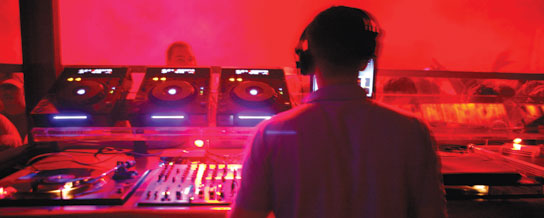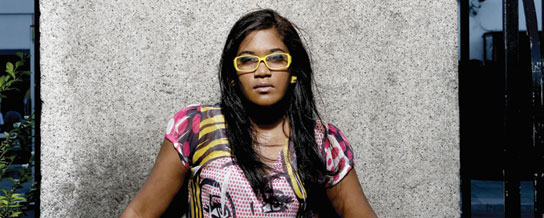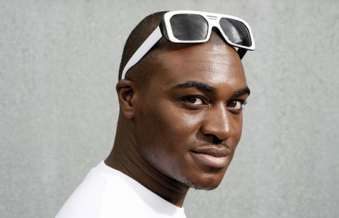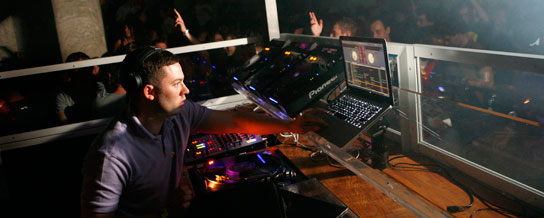Mutant Funk: Cooly G, Geeneus, and Roska take UK funky and dubstep back to the lab.
“This ‘funky’ thing, it’ll be over in a minute. You can only say something is […]

Mutant Funk: Cooly G, Geeneus, and Roska take UK funky and dubstep back to the lab.
“This ‘funky’ thing, it’ll be over in a minute. You can only say something is […]
“This ‘funky’ thing, it’ll be over in a minute. You can only say something is new once.” If anyone has witnessed a genre come and go, it’s Geeneus. The 30-year-old boss of London’s most influential pirate radio station, Rinse FM, Geeneus started broadcasting 15 years ago with guys like Wiley and Slimzee. They played strictly jungle back then; however, Geeneus is a self-professed “new thing addict” these days. He’s seen the arc of U.K. urban music burn through jungle, garage, and grime.
“The funky thing came about because girls had stopped dancing in clubs—[grime] was more of a show thing,” says Geeneus. “So people could just dance again, you know? It was 70% females. And now it’s gone the completely opposite way again.”
Already, in less than a year and half, the style that’s become known as U.K. funky has been banned, un-banned, and re-banned in countless South London clubs. Three generations of producers and DJs have effectively come and gone. And as the music crests toward perhaps a final stage, funky has splintered into a mutant, experimental phase via producers like Cooly G and Roska—right as the rest of the world has only just heard about it.
HOUSE UNDER CONSTRUCTION?
Funky has never been weird, experimental music. Or, rather, it hasn’t tried to be. Whereas dubstep and grime have often alienated dancers and driven away girls, funky’s aim has been to do exactly the opposite. The most basic funky track template, which rests on a simple house beat accented by soca-style snare gallops, is pretty traditional-sounding house; it’s dance music, literally. And the imagery it evokes—bongos draped in bikini tops, champagne glasses bubbling over, and a “no trainers, no hoods” dress code—well, that’s not particularly weird for dance clubs, either.?
Geeneus

“For me, it started after I was with some girls who showed me funky house music from the U.S.,” says Geeneus (who used to produce as Wizzbit, but whose real name is kept pretty hidden because of his renegade radio status). “I was a bit bored. I was listening to grime, making grime, and I was listening to this thing that was new to me—not to everyone else—but new to me. And, cool, I really liked it. So I went into the studio and made my version. And the first tune I done, ‘Emotions’ with DJ Zinc, it was very bass-driven. It was our way of looking at the music. It lost the house name and kept the funky name as a progression of that idea.”
Before guys like Geeneus got involved with funky, the roots of the scene were built during grime’s peak. Supa D, Fingaprint, Statix, and Wigman were among the first adopters, and their tastes were firmly in “soulful” dance music, meaning anything from “old skool” garage, soca, and broken beat to U.S. house producers like Dennis Ferrer and Karizma.
Anthems from funky’s early days tended to fall into one of two camps: on Fingaprint’s “The Print,” it’s all about cheap, bashment-style MIDI horns over a simple house thump; pizzicato chords ride alongside and emulate soca’s syncopated gallop. But then there are tracks like Fingaprint’s “Take Over,” where the beat is like a broken version of 2-step: organ bass plays off the kicks, but the accents are all weird. And maybe it’s just MC Creed’s tongue-twisting babble on “Take Over,” but it shares a certain resemblance to another suspicious predecessor: Zed Bias’ U.K. garage classic, “Here Comes the Lick Again.”
“When I was first going out to funky events, it was a lovely kind of music to dance to—it had such a nice vibe,” says Kyla, vocalist for Crazy Cousinz. Her single, “Do You Mind,” was one of funky’s biggest leaps into U.K. pop music last year, but since then, she’s branched off with producer Paleface into R&B territory.
“You used to be able to have a drink and dance, and the music wasn’t so in your face,” says Kyla. “But now, the music has gotten so hard, and you have all these MCs jumping on. They call out for these certain dances—they’re called skanks—and then fights break out because it hypes the crowd up on a different level. It’s like the music has gone off on a totally different side—it’s not soulful anymore. It’s like what happened with [U.K.] garage, really. Girls see a bunch of guys dancing with other guys and they’re like, why bother?”
?COOL THING?
As skank tunes and the influx of MCs have made funky come off like a cheap fad, the style that Cooly G, Roska, D-Malice, and Scratcha DVA are pushing is remarkably different. In a way, they’re like mutant traditionalists: They favor the sound of funky’s early days (where Fingaprint is considered a demi-god), but they’re taking a way more individualistic approach to the music. Scratcha DVA, for instance, is heavily grime-influenced (he was an engineer on Wiley’s Playtime is Over album). Roska’s production is super-minimal; he happens to be a big Zed Bias fan. And Cooly G didn’t even know about the Hyperdub label until its owner, dubstep DJ/producer Kode 9, signed her single, “Love Dub.”
“Promoters put me as ‘U.K. funky queen’ and all this funky/dubstep/broken-whatever,” says 27-year-old Cooly G (a.k.a. Merissa Campbell). “But to be honest, I don’t even know about any of that! Because, to me, the music that is proper U.K. funky is crap music. It’s just rubbish tunes that have not done the scene any good. I call it nursery-rhyme funky. But… even though we don’t really call ourselves U.K. funky, what we’re doing still is, because the funky crowd is bubblin’ to our music.”?
Cooly G

Cooly G, a single mother and a semi-pro footballer, was just making tracks on the odd Sundays when she had free time until recently. However, after the success of her first record, “Love Dub,” she’s been on a bit of a tear: She does her own night called The Producers House in South London, she’s been collaborating with Kode 9 and Scratcha DVA on new music, and she’s slated to have a TV crew follow her around this month to film how she gets it all done. Practically out of nowhere, she’s become the figurehead for what Geeneus calls the “4th generation” of funky.?
“There’s this other side of funky that Cooly, Roska, and I are into,” says Scratcha DVA. “Nights like FWD at Plastic People are pushing it, so it’s got more of a dubstep vibe. And it’s like, I played there with Kode 9 and Cooly G last week and I got a round of applause at the end! Now, if I go into any funky dances playing bare skank tunes, you think they’re gonna care who’s playing, bruv? No, they’re not gonna care, as long as you’re playing [Gracious “Nappa Man” K‘s] ‘Migraine Skank’ or whatever.”
WALKING THE LINE
?The cross-genre policy at FWD hasn’t just turned funky DJs on to dubstep, though—the dubstep guys have messed around with the other side, too. After Benga and Coki’s track, “Night,” was practically stolen by the funky crowd at Ayia Napa (the Cyprus island resort that’s basically taken Ibiza’s place as young Brits’ fave new vacation spot) last year, producers like Skream and Benga have continued to do slower, funky-style edits of their tunes. Meanwhile, labels like Hessle Audio, home to Untold and Ramadanman, have also carried on with a particular, busy strain of funky-influenced tracks.?
Roska

“There’s definitely a split within dubstep,” says Roska (a.k.a. producer Wayne Goodlitt). “I’ve talked to a lot of the guys—Kode 9, Shortstuff, etc.—and what I’ve heard is that you’ve got one side of dubstep that are playing that sort of ‘farting dub’ sound—that squeaking bass, you know what I mean? And then on the other side, there’s tracks with housier elements to them; they’re slowing them down, making them at 130 bpm rather than 140 or 145. It’s like a little merger—the darker side of funky meeting up with the housier side of dubstep.”
Headier examples of this merger are tracks like dubstep’s current anthem of the moment, Joy Orbison‘s “Hyph Mngo,” or Ramadanman’s “plsn.” The latter’s b-side, “Wad,” even apes funky’s soca vibe, but with a strangely studied romp of clangy percussion. “It was an early attempt at something at a lower tempo,” says Ramadanman (a.k.a. David Kennedy) of the track. “I’ve always been into house, even before dubstep. But on ‘Wad,’ I was influenced by [Rinse FM funky DJ] Marcus Nasty and the raw, percussive sounds I was hearing.”
Record stores like Boomkat, Juno, and Hardwax have noticed the lines getting fuzzier, too. Releases like Zomby‘s “Digital Flora” are often tagged as a mixture of funky because they’re slower, melodic, and not quite as atonal as dubstep tends to be. This also creates a jumble of not-quite-right genre descriptors, similar to the early days of grime when you had names like “sublo” and “eski-beat” still vying for the top spot.?
“’Funkstep’ is a name being thrown around at the moment,” says Scratcha. “I was there in the [Rinse FM] office when Geeneus first said the name. And, it’s like, with Skream, Brazen, Brackles, and these guys—it’s all becoming this one thing. And I got a feeling it’s gonna be called funkstep. Just watch, I can see it! And then the U.K. funky people are gonna come over, too, because they can’t get out of the U.K.”
??
FRACTURED FUTURE
?Although Geeneus claims “funkstep” was thrown around as a joke, if funky is any indication, these names tend to take on a life of their own.?
“If you look at some of the podcasts on the Rinse FM website, some of them are saying ‘house and funkstep,’” says Roska. “But maybe it’s too early to be labeling stuff, even if the music has this element of meeting in between. But I do believe that places like Ayia Napa this year, they gave people a bit of a wake-up call in that they’re not sure how long or how far funky will go. Because, at the moment, the genre has moved so quickly, it’s unbelievable. In the space of a year, you’ve seen it rise from loads of singing tunes to instrumentals to MCs jumping on. I don’t see none of it as a bad thing—all the parts have their place—but it’s just weird to see how fast it’s moved.”
It’s inevitable that part of that movement will include getting away from funky altogether. While it can be said there’s strength to sticking with a scene, it’s not uncommon for U.K. artists to use these quick flashes of hype as a springboard to something else. That seems especially true of an artist like Cooly G, who is probably too musically ambitious to stick with funky anyway.
“The album that I’m doing now,” Cooly G explains, “it’s got these bits of broken beat, dub, reggae dub, funky house, deep house—everything. It’s so uncategorized. But it’s like, right now, if people are putting put me under U.K. funky, I’m not really bothered. That’s how they’re gonna see it anyway—at least until something dramatic happens. Like when my album drops. And that’s gonna be big, I’m telling you that right now. I’ve got ten Dub Organizer EPs ready to release on the road; I’ve got Cooly and the Gang featuring Kode 9, Scratcha, and bare producers; I’ve got bare shit coming out and it’s just gonna cause more of this kind of discussion.”
Meanwhile, there’s yet another side of the funky crowd that has opted not to follow into skank territory or the dubstep-influenced side of things. They favor the four-to-the-floor style propulsion of early funky, but they’ve gone deeper and more percussive this time around. It’s a pretty new development as these things go, but based off Rinse FM sets, the music shares a bit in common with minimal house and techno, of all things.?
Geeneus at Rinse FM’s 15th Anniversary

“I’ll still play funky and whatever, but there’s a lot of events going around like Circle, where they’re playing more house again,” says Geeneus. “They’re calling the music ‘dubbage.’ They’ve come from funky and they’ve gone off on this other land, and there are loads of girls in the club. And while the numbers have gone down—it’s not 1000 anymore, it’s 500 again—it’ll be like 400 females. It’s gone completely back underground, too, below everyone’s radar.
“Everything’s a branch, and while one thing is getting done, another thing branches off,” Geeneus continues. “Sometimes the branch grows big and sometimes it’s just a quick little phase. Right now, this dubbage thing is a branch, and this branch is doing well. And you’ll listen to it and say it’s just U.S. house. But it’s people from the U.K. making it, and they’re coming with another angle.”
Given all this fragmentation and distancing and differing of opinions, you have to wonder: Is funky already dead? Probably not, although like the name itself, funky’s identity has always teetered on an ambiguous point. Which is kind of perfect, really: funky as an “anti-name,” the kind of thing born out of 20-plus years of genre-waving until everyone just got sick of it. Like, if you had to title every new fashion season something new, and eventually you were just like, “fuck it… let’s just call this season ‘clothes.’”
“Things come back around, and even though funky is called funky, really you could say it’s not that much different from garage,” offers Geeneus. “It’s just another full circle. With America, hip-hop is hip-hop, and even though the music changes and new sounds and people come into it, the flow remains hip-hop. But in the U.K., as soon as something new comes along, it’s like, “Oh, that’s new music—let’s call it a new name!” when really, it’s all the same thing. We just progress along. So I’m doing funky, Skream’s doing dubstep, Wiley’s doing grime, but we’re all together. We’re all on the same radio station, we all come from the same place, and we’ve all got the same influences. It’s really all part of the same continual flow.”
________________________________________________________________
TOP SKANKS
Skanks are kind of like the U.K. version of krumping or jerking—they’re dances, except MCs tell you how to do them. And, truth be told, they’re really funny and awesome from a YouTube perspective; however, in the U.K., it’s a phenomenon akin to listening to Soulja Boy every day for two years.
“Before funky was even out in the clubs and people were raving to it, people were skanking,” says Cooly G. “It all comes from the basics of reggae music; it’s just a term to describe how people are bubbling in the raves. But it’s crazy right now; there are some really stupid dances. Really terrible—you don’t wanna see it.” But just in case you do wanna see it, here’s a look at a few of funky’s foolish floor-fillers.
“MIGRAINE SKANK”
This might be the greatest skank of them all. Aside from being stupidly easy to do (you basically just hold your hands on your head and waddle down low), the track that goes with it is pretty good. Think: a kissing cousin to later-era U.K. garage, like DJ Narrows’ “Saved Soul” or Agent X’s “Turbulence.” Don’t forget to check out Gracious “Nappa Man” K’s instructional video on YouTube.
“HEAD, SHOULDERS, KNEES, AND TOES”
?The dance is pretty much what it sounds like (granted, it’s a little funkier), but the success of the actual song is totally perplexing. “[K.I.G. Family] were in the studio, having a laugh, and they made a little funky beat—they normally do rap and grime,” says Scratcha. “But [‘Head, Shoulders, Knees, and Toes’] got to the top 20! And obviously other mans were like, ‘Yeah, I know that guy, I can do that.’ So then you get loads of these other skank tunes about, videos on YouTube. It’s like the bashment sector of U.K. funky—you can go to a rave and hear nothing but tunes like this.”
“TRIBAL SKANK”
?The video for this song is fucked up, but it delivers a positive message. Basically, some Mr. Bean-looking dude happens on some dancers done up in “tribal” African make-up, so he tries to impersonate their moves while they skank around a burning barrel (it’s the ghetto, you see). After hitting his head on fences and stuff because he’s clumsy and white, it turns out the guy can dance—and so can a random assembly of grandmothers and police officers.
“SWINE FLU SKANK”
?Basically a mock-public service announcement, “Swine Flu Skank”’s big hook is “Catch it/Bin it/Kill it.” You might have guessed the dance roughly follows that idea. Best part of this song is the accompanying rap: “Don’t come round here with your flu symptoms/Cos I don’t wanna die, duuuude.”

